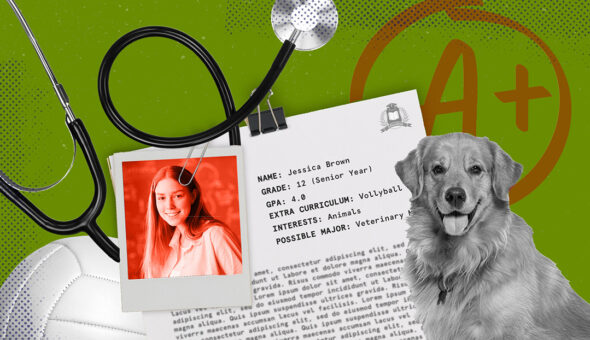Middlebury Magazine‘s Matt Jennings joins the podcast this week to discuss the publication’s COVID-driven transition from a print-first college magazine to a digital product that weds magazine thinking with digital production and strategy.
That has meant producing more timely content, developing a newsletter strategy, conceiving content as digital experiences instead of print, and more. It’s not that there wasn’t a digital product before, but the lack of a print issue has both challenged and freed Jennings and his team to create and promote their content in new ways, and Jennings says many of these changes will remain in place even once publishing and mailing a physical magazine is an option again.
Our Guest
Matt Jennings is the editor-in-chief of Middlebury Magazine and the editorial director for Middlebury College’s communications office. He is also the person Tom the Dog is always with when you see him around campus, and you might just recognize Tom’s voice if you’ve been to a Middlebury sporting event before…
Our Host
Heather Dotchel is the host of Higher Voltage. She is a Philadelphia-based higher ed marketing professional who most recently led two area colleges as their chief marketing officer.
Read the Transcript
Speaker 1:
Hi everybody and welcome to the Higher Voltage podcast brought to you by eCity Interactive. Here’s your host, Heather Dotchel.
Heather Dotchel:
Hello, and welcome to Higher Voltage, a podcast that explores the ins and outs of higher education marketing and touches on all aspects of the business of higher education. My name is Heather Dotchel, you have most recently encountered me leading the marketing and communications teams at two Philadelphia area colleges. Welcome to Higher Voltage.
Heather Dotchel:
I’m especially excited for this week’s episode because we’re talking about institutional magazines, which just so happened to be my path into the world of higher ed marketing and communications. Today’s guest is a well-known leader in the field. Matt Jennings, editor in chief of Middlebury Magazine and editorial director for Middlebury college’s communications office. In addition to running an award-winning publication, Matt regularly leads conference workshops, delivers keynote addresses, and gives webinars on editorial best practices. Plus he serves the larger higher ed community through cases commissioned on communications and marketing and via American society of Magazine Editors. But that isn’t all, Matt can you also explain the many hats you wear on Middlebury’s campus alone?
Matt Jennings:
I’d be happy to Heather, and thank you for such a flattering introduction. I feel a bit of imposter syndrome looking over my shoulder to see who you were talking to. But I appreciate it, I’m thrilled to be here. This is an amazing podcast that I’ve listened to since its conception, so I’m honored to be your guest. And yeah, at a place like Middlebury one of the things that I’ve loved during the 18 years I’ve been here is the opportunity to do a lot of different things. In addition to my official roles, as editor of the magazine and editorial director in the communications office, I feel like lately, at least the past four or five years, I’m probably most noted on campus for being the owner of Tom the dog, a golden doodle, who is a student favorite on campus who shows up, well, every day. When we were going to the office he came to work with me every day.
Matt Jennings:
So people see me and I think it’s, there goes Tom and the person who walks with him. So I feel like that’s one of my major roles outside of the day-to-day work. But I’ve also been involved with a lot of different things from advising the student newspaper in the past, to advising student multimedia productions, independent projects. I’ve been a thesis advisor for a student on her long form narrative journalism project. I’ve had the pleasure and immense privilege of co-directing a narrative journalism fellowship project with Sue Halpern, who is a scholar in residence at Middlebury and staff writer at The New Yorker, it’s something we’ve done for the past 10 years.
Matt Jennings:
So there has been an opportunity to really… I’ve had a radio show, not right now in the moment, but for about 10 years a radio show with a good friend of mine, a faculty member, and some people would ask, “Well, is it a talk show? A journalism show?” No, we showed up and played music, which it was kind of like arrested development for me. I had a radio show in college and to be able to do that as an adult has just been a thrill and I’ve just really gotten to… Been part of reading book clubs and reading clubs and things like that on our campus, a small residential college where there’s the opportunity to really expand and do a lot, be involved in campus life beyond the regular work week.
Heather Dotchel:
All right. Well, thank you for that. And although our listeners can’t see us talking, I did meet Tom the dog earlier and he is very lovely.
Matt Jennings:
He’s a sweet boy.
Heather Dotchel:
So when I reached out to Matt earlier this month, I wanted to talk shop, but I didn’t know exactly what direction I wanted to take. Obviously, our podcasts so far have been heavily influenced by COVID, but that isn’t always the lens we want, except when we do. Matt, based on conversations we’ve had before today, I know that navigating the pandemic is very top of mind, and Middlebury has had to make some tough choices. You’ve shared with me that Middlebury Magazine is suspended from its print version right now. Can you give us background on that and how you plan to weather the change?
Matt Jennings:
Yeah, absolutely. We’re still in this surreal world that kind of hit us, if not all at once, close to all at once back in March. And I can even pinpoint the exact date, which was a couple of days after… My birthday is March 8th and it was a couple days after that when Middlebury college made the decision that we were going to send all our students home. At first the decision was we’re going to start spring break a week early and then after that re-evaluate. And then it became, the students will stay remote and we’ll finish the semester and the academic year learning remotely, teaching and learning remotely.
Matt Jennings:
That had an immediate impact on Middlebury’s budget, its operating budget, because once the students left in March room and board for the rest of the year would be prorated. We were immediately looking at a budget deficit and across the board every department was asked, “How do you cut your budget by X percent?” I can’t remember the exact amount. And we just knew at that moment in conversation with my boss, that the spring issue that we were working on in March, we were a month away from sending files to the printer, that we would not be publishing our spring issue in print. And so we metaphorically hit pause right then and there. And as the months progressed and the institution began to make further decisions, institution-wide decisions that had budget implications, everything from recognizing that… We have graduate schools in the summer on campus, and recognizing that we were not going to be bringing students to campus in the summer, which would mean more impact on the budget, to a fall semester that would look different than past semesters.
Matt Jennings:
The institution wisely and correctly, in my opinion, put a stake in the ground and said, “As best as possible, we want to maintain wage continuity for faculty and staff. We want to support our students and whatever budget implication there is it should not be on the backs of faculty, staff, and students.” So throughout the pandemic, as an institution, we have not resorted to furloughs, we have not resorted to layoffs, benefits have been maintained and protected. So, what that means is our operating budgets have been impacted, in some cases pretty severely. Those relating to student life not so much, as it should be, or the academic side of the house. There is obviously extra spending that needed to be done around COVID. And so when we were looking at the FY21 budget for our office, my boss, David Gibson, and I sat down and we just said, “This pause is going to have to continue into the academic year.”
Matt Jennings:
And so what does that mean? One of the things that I’ve emphasized with our constituents is that this is a pause, we understand the value of a print magazine. Heather, we’ve had many conversations in the past, I think people understand that I am a print evangelist. I love the power of print, I think there is a place for it. In this case though ink, paper, and postage, we can’t afford it, if we are as an institution to hold firm to our values, which we are. So for me, the challenge became, what do we do? How do we maintain this relationship with 50,000 readers? And that’s basically our circulation. How do we maintain this relationship without that print vehicle?
Matt Jennings:
We’ve had a quarter week… Middlebury has published a quarterly magazine in some form, either as a magazine, or it was called a bulletin at one point, it was called a newsletter, but there really was a magazine since 1923. So without any interruption at any other time. So, what do we do to maintain that communication with our readers and that engagement and that… Especially at a time where everyone is feeling adrift, they’re feeling unmoored. So that became immediately in March became the challenge that was presented to me.
Heather Dotchel:
Let’s take a quick break to say that today’s Higher Voltage podcast is brought to you by eCity Interactive. For more than 20 years eCity has been creating marketing strategies, websites, and digital experiences for higher ed institutions large and small. Inspired by challenge and proven by results, eCity can help you solve the greatest challenges facing your institution today.
Heather Dotchel:
Let’s talk about digital magazine strategy then. Many institutions, and Middlebury was also a leader in this, have had complimentary digital presences to their print publications. What did that look like prior to COVID shaking up our higher ed world?
Matt Jennings:
That’s a great question. I heard a podcast with Jeffrey Goldberg who was the editor of the Atlantic, used to be called the Atlantic Magazine now it’s just the Atlantic. And he was posed the same question, and let me just give the caveat I’m not comparing myself to Jeffrey Goldberg or Middlebury magazine to the Atlantic in any regard, but I liked what he had to say and I thought it applied to us in a certain way, at least in the world of higher education magazines. And Goldberg had said that the Atlantic had a preexisting condition when it came to their publishing strategy before COVID. And that was that they had a digital magazine, or a digital experience, that was complimentary to the monthly magazine, but was not a duplicate or a one-to-one match.
Matt Jennings:
I feel like we were in a similar place, now we did not have, and still do not have, a digital experience that is exclusive to what we were doing in print. But what we had decided on several years ago when we redesigned the digital magazine, or were rethinking what the digital experience should be for our readers was… We made two decisions, it was we were not going to take everything that existed in the print magazine and put it online, we were only going to put content online that we had a great digital strategy for. If we felt like we could deliver digitally and I in a terrific way, great. If we didn’t have that solution we were not going to try and shoehorn it into the online experience. So we had already had a digital magazine that was not a one-to-one match with print.
Matt Jennings:
We also went about the content design in a way that was not, again, was not like you were looking at, “Okay, this is what’s in the print issue.” It was a design choice, a functionality choice that we said, “If we’re creating something for the online experience, let’s tailor make it for the online experience.” So you didn’t go through the online magazine in the same way you would page through the print magazine, where the front of the book feature well back of the book. What’s different than the Atlantic is that we don’t have hundreds of people working on print and digital, so much of the content online still came from the print, still were stories that appeared in print with the exception of some multimedia pieces that were created specifically for the magazine. But I still feel like 80% was content that had appeared in print that we were then re-purposing for digital.
Matt Jennings:
So in that regard we were a print first, we had a print first strategy. And when March hit and we were not going to be producing something in print, I said, “Let’s rip up what we were doing for the spring print magazine. A, Because the world was very different than what we had imagined back in February, January, December. And let’s use this opportunity to think just about digital. And that includes what stories do we want to do right now and how do we want to present them?” So we immediately became a digital first organization without that print. And it was great in that it allowed us to navigate a landscape that was changing every day from a story standpoint. One of the things that I’ve said to some folks is, “I can’t imagine, even if we had the budget for it, I can’t imagine how we would produce a relevant quarterly magazine right now, because what we’re working on now, by the time it would come out in print it could seem woefully out of date.”
Matt Jennings:
So one of the luxuries of working in the digital space at that time was we could rethink the stories we wanted to tell and publish stories that were more relevant in real time. Now, not news stories per se, but just essays or features that were more relevant to that time. And we can do it in a way that we recognized, “Hey, we’re doing this for the digital audience.” And so that was the first hurdle to get past was what do we want to produce and how will it appear? And then the next big challenge was, how do we get people on board with this? How do we reach those eyes and ears?
Heather Dotchel:
So, let’s talk about what that strategy looks like now. You’ve taken a situation with budgetary constraints that arises from the pandemic, and you’re looking at it, and not only are you saying, “This is the right decision to make, because we need to prioritize our actual people needs on campus.” But you’re also reframing it, as you speak right now, very much as an opportunity to get this primely more environmentally relevant publication out there. So what does that strategy look like? I know when we’ve been exchanging messages about this, you specifically called out engagement as a guiding force.
Matt Jennings:
Right. Yeah. So, one of the biggest things, and one of the many reasons why I love a print periodical, is that if you are creating something that’s worth reading and it’s good, you have a great delivery vehicle because you’re going into people’s homes. If it’s visually appealing they’ll keep it around, if it is well-written and provides stories that people want to engage with, they will read it. They don’t have to go find it, they don’t have to find it on the newsstand, as long as they’re going to their mailbox they have it. So, the biggest challenge we faced was we don’t have that push strategy anymore. It’s more of, I’ve heard people describe it as push pull. So we’re pushing the print magazine out, but we need to pull readers into our digital experience, we need to bring them to us.
Matt Jennings:
And how do you do that? As much as I consume and devour print periodicals, I also do online in a different way, but I very rarely type into a URL www.newyorker.com. I’m not going to the New Yorker that way, I’m not going to the Atlantic, or sports illustrated or whatever. I need to be brought there. So I had been talking with David, my boss, about a magazine newsletter before COVID, before the pandemic, just saying that there are opportunities to reach readers beyond print. If we are serious about beefing up digital we need to find a way to bring them to us. And newsletters… This is not an original idea, the past several years have really taken hold in the community of journalism. Every magazine seems to have a newsletter from the editor. Now we’re seeing journalists going out independently with sub stack and creating their own newsletter. So, newsletters are the 2020 version of what blogs were when blogs came out. And so we needed… I felt we needed to be in the newsletter game, again, pre COVID.
Matt Jennings:
COVID happens and it’s like, okay, we need to be in the newsletter game tomorrow. It’s not something we want to do soon, it’s something we need to do now because they’re not getting that spring issue. I mean, people are still thinking that issue is coming in April and it’s not. So we need to communicate with people, A, to tell them about that, and we need to tell them, “But we have this great content online, come join us.”
Matt Jennings:
So the original idea for a magazine newsletter was monthly, we decided at the outset it needed to be every other week. So every two weeks there would be a newsletter. And I was really intent on having a newsletter modeled after what I was reading. And so that was like the newsletter that David Remnick sends out from the New Yorker, or Sam Sifton, from the New York Times cooking channel that was very conversational. It was the voice, not only of that publication, but of that editor in a way that I felt like I was getting an email from that person telling me, “Hey, you should read this, that or the other, if you have limited time.” Or “You should try cooking this over the weekend if you have the time.”
Matt Jennings:
So the decision would be that it was not going to be a Middlebury Magazine newsletter with a list of image and story, but it would rather be branded from the editor’s desk. And it would be written as if I was writing each reader personally, Dear Middlebury magazine reader, signed by me at the end. And I structured the newsletter as kind of a lead paragraph. Here’s the first thing I want you to know about, and just a little essence of storytelling in that graph of, “Let me tell you a little story, and then here’s what you read to learn more about it.”
Matt Jennings:
A second block would be letting people know what we are creating, because as we moved to the digital realm we were no longer on a three month cycle of publishing a print magazine. And I think that was a decision I wanted at the outset. It was even something that I wanted to gravitate to, again, before COVID which was, there is no reason to be beholden to a print editorial calendar with a digital realm. You just don’t need to, you could publish all throughout if you have the bandwidth and the dedication to do that, and you feel it’s a priority.
Matt Jennings:
And so I wanted people to know that we were going digital at this time, but that did not mean we were publishing stories in the spring and then you wouldn’t hear from us again until we publish stories in the summer. Rather we’d be publishing stories continuously. Not every day, because again, we’re not Slate, we’re not the New Yorker, but we will be publishing continuously. So the second block of that newsletter was what we’re creating and let people know, “Hey, there’s new content, go check it out.”
Matt Jennings:
And then the third piece, which I really like probably the best of it all, and people have really gravitated toward. Which it has nothing to do with Middlebury Magazine other than here are stories recommended by the magazine staff. And it’s called what we’re reading and watching. And invariably everything is Middlebury related, I’m letting people know about an alumna who now has a podcast with the Believer Magazine. Or I’m letting people know about the graduate of the Middlebury Institute of International Studies at Monterey who appeared on 60 Minutes, go watch this. Or the faculty member who has written this piece in the New Yorker, Sue Halpern wrote this, go read that. So it’s recommended reads and watches involving Middlebury people, but nothing that we published.
Matt Jennings:
I found that that’s been one of the most popular pieces. People are often referencing that when I get feedback from folks. I’ve also gotten pitches, “Hey, I just wrote this book, can you mention in what you’re watching and reading?” So I’m getting pitches for that particular area of a newsletter in the same way I used to get pitches for stories for the magazine. And I’ll also say I knew without looking at analytics, I knew that we were on the right track with that very first issue, we’ve done 12 or 13 now. That very first issue from the editor’s desk, when I got 75 responses, email responses, and they were all “Dear Matt, Matt, hi Matt.” They were all writing me back personally, now the return address was me, but I knew it was effective because they received it as a personal communication for me. And they were responding in kind. And that was immediately gratifying and let me feel like okay, we’re on the right track with this.
Heather Dotchel:
Oh, that’s fantastic. Can you share some of the analytics beyond? I mean, the time it takes for 75 people to sit down and write an email, I mean, that’s the gold right there.
Matt Jennings:
Right.
Heather Dotchel:
But where your analytics also showing data support?
Matt Jennings:
Yeah. So, you hear all kinds of things about best practices or kind of like what the key figures are for open rates for emails and click through rates on various stories. I have heard that anything over 25% open rate should be considered a success for emails that have not been subscribed to or it’s opt out. So we sent the newsletter to everyone we have a valid email address for and they can unsubscribe, but it’s not a subscribed based. So people have not opted in, they should opt out. So I’ve heard with the opt-out model anything over at 25% open rate is good. We’ve frequently been above 50, I don’t think we’ve been below 40, maybe high 30% some. And it depends a lot on what day and time we’re getting it out, but we’ve done really well we think with the open rate.
Matt Jennings:
And same with the same with the click through rates, we’re seeing people clicking through on links. 25, 30, 35% of all users are actually then following through to click through on a story in that first hour. And again, that’s immediate and over time you do get the most traffic in that first hour when someone gets it, but it still ticks up over time. So from an analytical standpoint I feel good about it.
Matt Jennings:
And then anecdotally, there are just little things when I hear someone saying, “Thank you so much for filling a void.” “Thank you, we understand what you’re up against as an institution, and thank you for still thinking of us and connecting us in this way with the life of Middlebury.” I couldn’t script those better. There are people who still think, or haven’t read through all the way that the print magazine is paused and they’re upset. Actually, I like that they’re upset when they think we’re not printing ever again, and I reassure them that we will when it’s fiscally responsible to do so. And they understand that, they get that. And even those folks who can kind of grumble about what they’re hearing from us, you’re focusing too much on X, Y, or Z. They’re still responding. And I think that’s a great thing.
Heather Dotchel:
Yeah. I never minded letters to the editor of any tone when I was handling magazines, because if people took the time to respond-
Matt Jennings:
They’re the best.
Heather Dotchel:
… they were taking the time to interact with what we were doing.
Matt Jennings:
That’s absolutely right.
Heather Dotchel:
So who else is doing this kind of thing well? Where are you looking for inspiration and collaboration?
Matt Jennings:
In higher ed Stanford is the gold standard as far as I’m concerned, from a digital… They’ve always had a good print magazine, I know they agonized for about a decade… I’ve had off and on conversations with Kevin Cool at Stanford about what they should be doing in the digital space. And they are doing things really well. I get it, it’s Stanford, but we always should have places to aspire to and models. They have a terrific… I believe they’re still printing, but they have a terrific digital presence. And again, they had that before COVID so they were in a great spot to continue outreach to people. Sticking with California, Loyola Marymount, again before COVID with their digital periodical. They were one of the first to have podcasts, they have had video, they’ve had behind the scenes. So they’ve been embracing the possibilities behind digital.
Matt Jennings:
I’ve been kind of looking around at some of the other places those that frequently win awards for their print magazine, and they’re doing visually impressive work digitally, Lake Forest, that’s Oberlin, that is Dartmouth. But one of the things I’m not seeing outside of Stanford is kind of this approach of, “Hey, let’s think about digitally differently, not just in how a story is delivered in terms of what content assets you bring into it.” But I haven’t seen, and maybe I’m just off base, maybe I’m going down the wrong road, but I haven’t seen anyone saying, “You know what? Let’s go create a digital publication that has this digital first strategy.”
Matt Jennings:
And this is where we’re going, I know when print comes back… And I can’t say whether it’s this spring, this summer, next fall, but I know print will come back for Middlebury. When it does I do not expect our print magazine to look exactly like it did and to exist the way it did with the last issue we printed, which was last winter. There are several variables we control, which is frequency, we’re quarterly, there is circulation size, which is about 50,000, and we’re a 96 page… It’s a significant book, 96 page magazine. When we come back, I think we need to maintain the quarterly presence, I would love to keep the circulation, but maybe it’s not as big a book. And maybe our approach to content is different because we’re publishing digitally first, and then what we’re doing in print is a curation of that digital footprint.
Matt Jennings:
So we’re flipping things on its head, and it’s not that I expect the primacy of print to fade. I still think that a vast majority of our readers will say, “I want print first and foremost, and I will engage with digital.” But I think the way we approach content will be different in that there will be an intentionality about what’s created digitally and what’s created in print. I see Stanford doing that, I haven’t seen a lot of others doing that the same way. And again, I could be an outlier and way off base and everyone else is on the right path. But I think one of the things that this pandemic has shown us is we need to be nimble, we need to think intentionally about how we reach our audience, and we need to make the most of our resources.
Matt Jennings:
I feel the timing of me talking to you is fortuitous from my standpoint, because I was having a conversation with some folks in the office via zoom about we’ve turned the corner from where we were in the spring, which was “Okay, what do we do? How do we maintain engagement? How do we make the digital experience more robust?” One of the channels we created was this channel called dispatches that had no connection to the print magazine, and wouldn’t if we started the print magazine back today. It is distinctly for the digital realm, and it’s these quick hit stories that we’re delivering at least once a week, or a couple times a week. But we’ve gotten past that point of the treading water, I think, and sometimes treading water with waves crashing over you it’s hard to think about actually moving forward. But I think we’re just now at the point… And I was talking with folks about, “Okay, come January, where do we want to be with our digital strategy? How are we even… We’re no longer treading water, we’re being more intentional about what we’re creating online.”
Matt Jennings:
And I want that to then lead into, “Okay, let’s start thinking about print.” How does print exist in this ecosystem along with this digital experience that we have.” And I could be naive on this and I could have people saying, “Matt you’re crazy, you have the same amount of people, talking about doing twice the amount of work.” I can see how that could appear, but I’m hoping it’s not, I’m hoping it just becomes more intuitive for us and that we’re building to kind of first in class experiences. But I think we need to… Without the fiscal budget to do something in print, we can’t afford paper, we can’t afford postage, and we can’t afford ink right now, but I do have a modest budget for creative. And we should really embrace that and figure out, “Okay, how do we build this first in class digital experience, and bring people to it, and have them engaged?” And then figure out what that means for print afterwards?
Heather Dotchel:
Well, perfect. That seems like the most excellent coda for this discussion, as we come back around to print to the end.
Matt Jennings:
I do want to say one last thing, a hero of mine, and you might’ve heard Jacqui, Jacqui Banaszynski either speak in person at conferences, or she also does a lot of webinars. She won a Pulitzer prize for reporting back in the eighties at the paper in Minneapolis, but then became an editor, an amazing editor and amazing editorial coach and story coach. She taught forever. I heard her speak, someone asked her and she had the perfect answer for someone saying, “Is print dying?” This was a decade ago, and we’ve been hearing about the death of print forever.
Heather Dotchel:
Never.
Matt Jennings:
Yeah. Certain types of… I wouldn’t want to be publishing a weekly magazine in print right now, I think quarterly’s will be fine. But she said, “What the more salient question is, is storytelling.” And that’s what people really engage with. And it’s the stories, not so much how they’re delivered. And yes, print is a technology, I want to tell people that, as much as a tablet is, so is your printed magazine. And it’s a technology we should use, but it’s still a delivery vehicle for a story. And Jackie had this line that stuck with me. And she said, “As humans we have been telling stories since we first started sketching on the sides of caves. And we’ll still be telling stories when we’re writing on the stars.” And I thought that was perfect, and that’s something I kind of hold close to my heart when I have existential angst about my career, and what if my son wanted to do what I do. And I just kind of say, “You know what? If that’s what you want to do, learn how to tell stories and be a storyteller, because everyone’s going to need that.”
Heather Dotchel:
Thank you for that.
Matt Jennings:
Of course.
Heather Dotchel:
All right, so we like to end each podcast with a little something else, whether it is a complete 180 from our topic or something related. What I’d like to talk about with you is your side gig at Middlebury as an official announcer and the responsibilities that come along with being a known voice.
Matt Jennings:
Yeah. So thanks. Just as I had mentioned earlier, there are some people who know me only as the human that accompanies Tom the golden doodle. I know that there are people in the community who think my job and the only job I do and have is as the public address voice at Middlebury sporting events. They know me that way and they’re actually surprised when they learn that I edit a magazine and do other things.
Matt Jennings:
So when I came to Middlebury 18 years ago, I was coming from working at an independent school, K through 12 in Washington, DC. And, again, one of the great things about that environment in addition to communications work, and editing, and editing a magazine is I coached high school sports. I was a JV basketball coach for this high school team, and I was assistant for the varsity lacrosse team.
Matt Jennings:
I knew coming to Middlebury my coaching days, at least at a level beyond kind of rec sports for my son was over, but I wanted to be involved in athletics in some way. And so I would hang around the gym and I would talk to coaches and go to all the games. And there was one day where the person who was supposed to be doing the public address, announcing for a men’s lacrosse game couldn’t be there. And so in a pinch, the head coach said, “Matt, you know lacrosse, right? And I’ve heard you on radio, your voice is pretty good. Would you want to do the public address announcing?” So I said, sure. And so I did that game, I loved it. It was a way to kind of see the game actively, if not as a coach more than as a spectator.
Matt Jennings:
So I started with lacrosse, but then I soon had conversations with someone who is near and dear to me and to you, and that’s your uncle, Jeff Brown, the men’s basketball coach at Middlebury. Jeff knew at the outset that basketball was my first love, I probably talked to him way too much the first time I met him about players I had coached against at the high school level, who he had coached against at Middlebury who were at other NESCAC schools. And I had said to Jeff… There was a great student at the time who was an announcer, he sounded just like the professional PA guy for the LA Lakers, just really great. But I knew he was going to graduate, he was a student. So I said, “Jeff, I have no intention of supplanting who you have, but I would love to kind of look into that role if and when it becomes available.”
Matt Jennings:
He knew I did lacrosse games and so he said sure. And there were a couple of times where this kid couldn’t be a games and so I kind of filled in for him. I guess I did well enough that after he graduated, Jeff said, “Would you like to do this permanently?” I couldn’t have said yes fast enough. I tell your uncle he has given me the best seat in the house, which is court side, but without any of the stress and responsibilities of actually coaching like I used to do. A side benefit, I think, for him and those around me, I can be a pretty vocal fan. And I think by putting me behind the mic, I could put my enthusiasm into something professional as opposed to something that could be seen as profane or directed toward referees. Which Jeff has said the best thing he ever did to protect the refs was putting me behind the mic because I could not yell at them as a public address announcer. But it’s been a great way also to be involved with the students.
Matt Jennings:
And I had missed that, missed coaching student athletes. And I’ve gotten to… They embraced me and others as part of the program, and a lot of it was my son, John. He was kind of around since he was two years old doling out high-fives before the games, and the past several years he’s been an official ball boy for the team. And so they’ve been kind enough, the coaches, the student athletes, and the parents of the student athletes to kind of welcome us into that fold. I have very good friends now of parents of now Middlebury alumni, their kids graduated 10 years ago, but I’m still texting with the dads during games because they’re still watching games. And we’ve gone to the weddings now of players who graduated that I never would have imagined doing that because I’m not their coach, I’m this guy. But we’ve gotten to know them because they’ve kind of pulled us into the family and that’s been really special.
Matt Jennings:
And I give all credit to your uncle for doing that. I walked into this place, I don’t want this to sound like, “Oh, I’m famous.” But I walked into this deli in town that I don’t go to all that often, and I went in and the guy behind me, when I said what I had, he goes, “I know you, you’re… Welcome to Pepin Gymnasium.” And I started to laugh and I was like, “I can’t believe I’m getting recognized for that, but it’s true.” And then we kind of lamented that there aren’t games to call now. And so I do, I feel a little unmoored that during the academic year I’m doing games for the soccer program in the fall, the basketball program in winter, and lacrosse in spring. And that’s just not happening and I’m sad about it. Not nearly as sad as I am for the student athletes themselves and the coaches themselves. But it’s definitely been one of the highlights of my time here.
Heather Dotchel:
Can we get an official voice, “Welcome to the Higher Voltage podcast.”
Matt Jennings:
Sure, I’m a little out of practice. But let me think, let me see here. Hi everybody and welcome to the Higher Voltage podcast brought to you by eCity Interactive. Here’s your host, Heather Dotchell.
Heather Dotchel:
Excellent, thank you for playing along.
Matt Jenning:
Yeah, of course.
Heather Dotchel:
Matt, before we go can you let our audience know where to find you online?
Matt Jennings:
Absolutely, please check us out. The magazine website is www.middleburymagazine.com. That will take you directly to us, we also have a Twitter account @Middleburymag. I also have a Twitter account though I’m not sure you want me to give them out my own, but it’s @MVJennings. I do talk about magazines and editorial best practices, but every once in a while I steer off into commentary about university of Virginia athletics. So bear with me on that. And then the… I want to plug the institutional social media, the Instagram account @Middlebury, which does a lot with our digital content as well as everything having to do with life at Middlebury and Middlebury College.
Heather Dotchel:
All right, fantastic. That’s a wrap. We’re very grateful to Matt for taking his time today to join us. And we’re looking forward to more great conversations with higher ed thought leaders in the weeks and months to come. If you’d like to explore a topic further, please feel free to reach out to me on Twitter @HDotchell.







